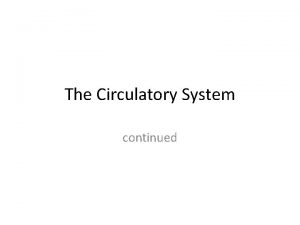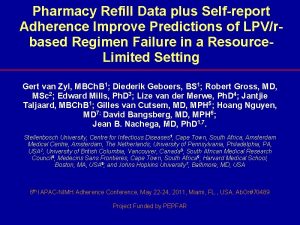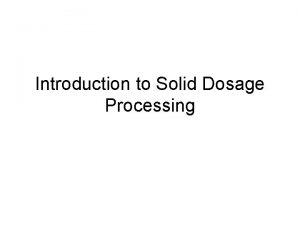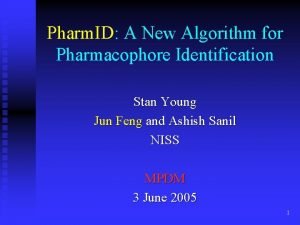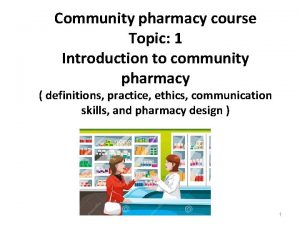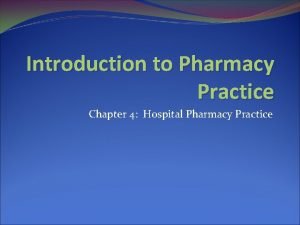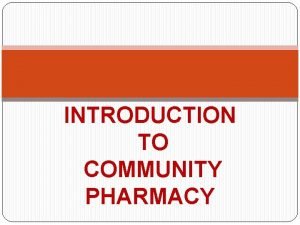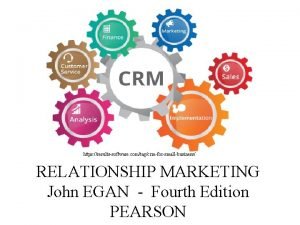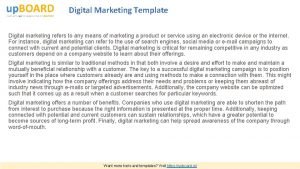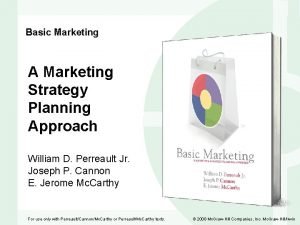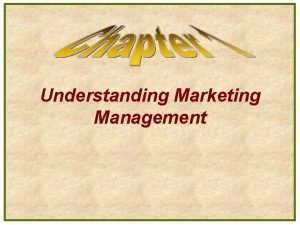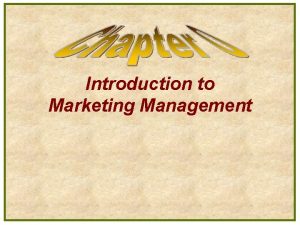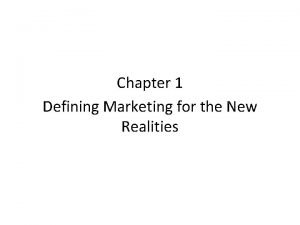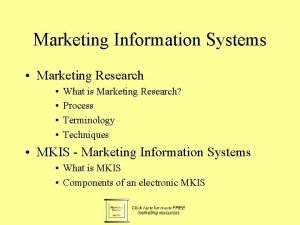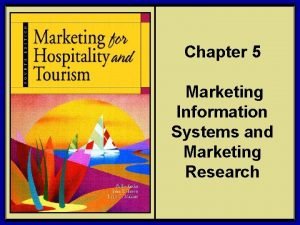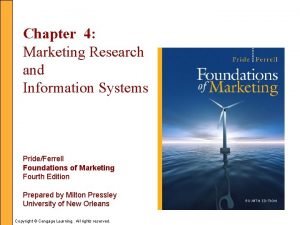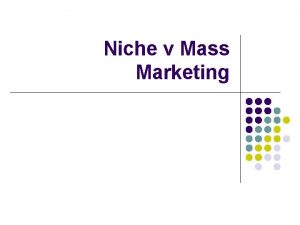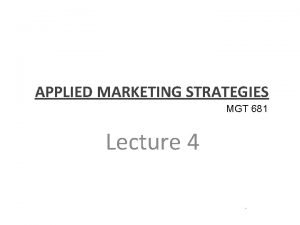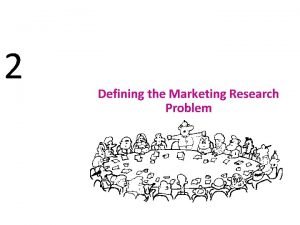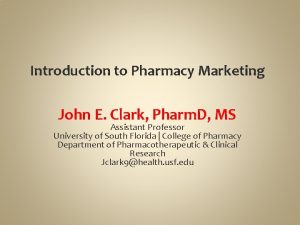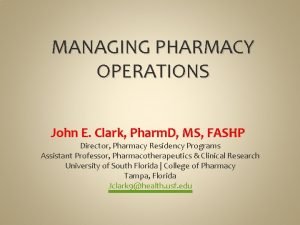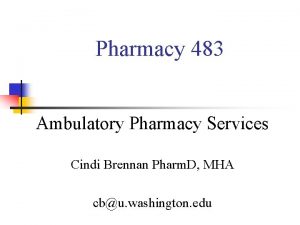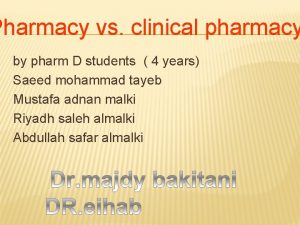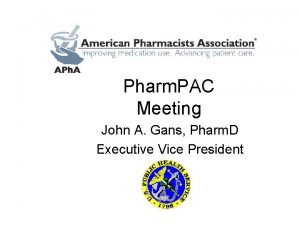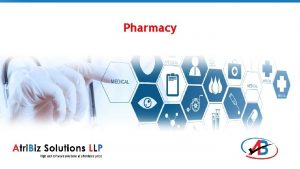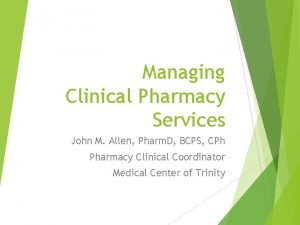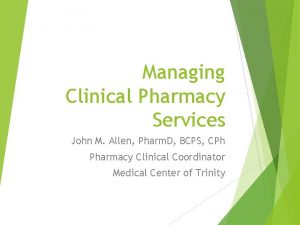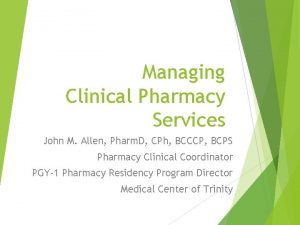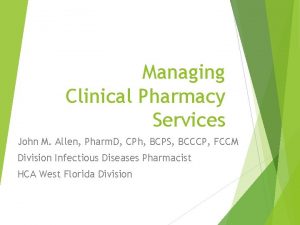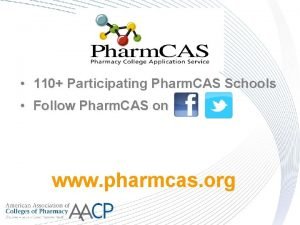Introduction to Pharmacy Marketing John E Clark Pharm






































- Slides: 38

Introduction to Pharmacy Marketing John E. Clark, Pharm. D, MS Assistant Professor University of South Florida | College of Pharmacy Department of Pharmacotherapeutic & Clinical Research Jclark 9@health. usf. edu

Learning Objectives At the end of this lecture, student should be able to: Define the term marketing Describe four key elements associated with the act of marketing. Identify environmental factors impacting the market for pharmacists Understand how to develop a marketing strategy for pharmacy

Definition of Marketing “The activity, set of institutions, and processes for creating, communicating, delivering, and executing offerings that have value for customers, clients, partners, and society at large. ” American Marketing Association

Definition of Marketing “Exchanges between people in which something of value is traded for the purpose of satisfying needs and wants”

Why study marketing? Marketing is A way of problem solving in the real world A way of influencing others Application of marketing can Help you get the job you want Make you a more effective pharmacist

Misconceptions about Marketing

Misconceptions about marketing Marketing is selling or advertising.

Marketing Research Selling Pricing Marketing Advertising Merchandising Distribution

Other misconceptions about marketing Marketing is evil. Health care professionals do not need to market. Employee pharmacists do not need to market. Only retail pharmacists need to market.

Every pharmacist is a marketer.

Everything pharmacists do can be called marketing: ● Dispensing a prescription drug ● Assisting patients in the selection of OTC medications ● Providing drug info to patients or health care professionals ● Taking a patient’s blood pressure ● Counseling patients about drug regimens ● Recruiting pharmacists for a new job ● Educating pharmacy students

Who Does Pharmacist Have Service Exchanges With? Patients Physicians, Nurses Third-Party Payers Employers and Administrators Supervisors and Staff Pharmacist Colleagues and Co -Workers

Pharmacist Service Exchanges The Economic Value has been Demonstrated Target Drug Monitoring Drug Therapy Interventions Consultative Activities

Pharmacist Service Exchanges Where Positive Outcomes have been Demonstrated Pharmacokinetic Monitoring Aminoglycosides Vancomycin Therapeutic Drug Monitoring & Interventions Physician Orders and Medication Reconciliation Warfarin Participation in Medical Rounds Inpatient Medication Teaching

Pharmacist Service Exchanges Where Positive Outcomes have been Demonstrated • Dispensing a drug • Helping patients select OTC medications • Providing drug information to patients or health care professionals • Taking a patient’s blood pressure • Counseling patients about drug regimens

Key Concepts Value is central to marketing Value is personal Value vs benefit Value vs Cost of exchange Value = Perceived benefit / Perceived cost Marketing is best understood as Communication Target audience Events Face-to-face Press release Advertising Sales promotion

Marketing Mix and the 4 Ps ●Product ●Price ●Place ●Promotion

Total Product Offering ●Includes all aspects of the product considered in the purchase decisions. ●Actual Product ●Core Product ●Outcomes ●Benefits

Product Benefits ●Outcomes: Does the product Meet the Customer’s perceived need? ●Compatibility: Does the product fit with the consumer’s lifestyle? ●Convenience: Is the product easy to use? Is the product/service easy to access?

Product Benefits ●Social Impact: Does the product offer prestige to the customer or Does the product embarrass the customer? ●Emotional Impact: Does the product have an emotional attraction to the buyer?

Price ●Cost-Base Pricing: Markup pricing Price = Cost * (1 -desired markup %) ●Demand-Base Pricing: Considers customers’ reaction to price; impact of price on purchase volume

Place ●Impact customers access to the product ●Design of the physical layout of the location ●Size ●Proximity

Promotion ●Advertising ●Sales Promotion ●Personal Selling ●Publicity

Understanding the Marketing Environment ●Market Research ●Secondary Market Research ●Primary Market Research ●Qualitative research ●Quantitative research

Environmental Analysis: Factors to Consider ●Macroenvironmental Factors ●Economic factors ●Legal and regulatory factors ●Social and cultural factors ●Technical factors ●Microenvironmental Factors ●Capabilities of the business

Marketing Plan Facilitates systematic thinking Helps to anticipate future events Allows for coordination of all activities involved in the marketing of the product Facilitates objective evaluation of success and failure of marketing tactics

Structure of a Marketing Plan Executive Summary Situation Analysis Environmental analysis Macro and Micro Category analysis Customer analysis Planning assumptions Objectives

Structure of a Marketing Plan Product / Service Strategies Tactics and marketing programs Financial documents Monitoring and controls Contingency plans

Transactional vs Relationship Marketing • Parties focus less on bargaining hard for deals and more on meeting the needs of the other party. • Marketers cultivate relationships over time that will benefit both parties. • The choice Transactional marketing – get what you can and get the patient out of the door Relationship marketing – every interaction with a customer is an opportunity to help the customer and strengthen the relationship

Characteristics of Relationship Marketing • Develop a relationship with customer. • Collect and manage customer information. • Individualize your services to customers. • Involve front-line personnel. • Emphasize long-term outcomes. Pharmaceutical Care Establish therapeutic relationship Assess and record patient needs. Create an individualized care plan. Delegate clerical tasks to free up time for professional duties. Monitor impact on patient outcomes.

Is pharmacy practice predominantly transactional or relationship-oriented? Transactional Orientation Relationship Orientation

Approaches to Addressing Marketing Problems in Pharmacy The way you approach a problem will determine how it is solved.

Some process-centered approaches to marketing Production – fast and cheap Sales – fast and cheap with heavy selling Product – better mousetrap

Customer-centered approaches to marketing Marketing concept Needs and wants Targeted customers Products and services that satisfy Societal marketing Considers societal impact

What is the dominant approach in pharmacy practice? What is your approach?

Key problems with marketing pharmacist services Control of practice by non-pharmacists Product orientation Conflicting professional and merchant roles Poorly defined image of pharmacists among public Pharmacist shortages Silos of health care

Summary Marketing can change your way of thinking about current pharmacy practice. Application of marketing principles can help you change pharmacy practice. Marketing can give you the tools to successfully promote yourself, your ideas, and the profession.

Learning Objectives Define the term marketing Describe four key elements associated with the act of marketing. Identify environmental factors impacting the market for pharmacists Understand how to develop a marketing strategy for pharmacy
 Functions of marketing by clark and clark
Functions of marketing by clark and clark What is the transport system of the body
What is the transport system of the body Library.med.utah.edu/kw/pharm/hyper heart.html
Library.med.utah.edu/kw/pharm/hyper heart.html Outfield pharm
Outfield pharm Letazol
Letazol Pharm406
Pharm406 Bc bio-pharm
Bc bio-pharm Pharm link
Pharm link Pharm gkb
Pharm gkb Secur pharm
Secur pharm Noel pharm
Noel pharm English for pharmacist
English for pharmacist Pharm
Pharm Klucel exf pharm
Klucel exf pharm Friciton
Friciton Pharm id
Pharm id Peptide api manufacturers
Peptide api manufacturers The apprentice pharmacist
The apprentice pharmacist Emergency drugs in crash cart
Emergency drugs in crash cart Introduction to community pharmacy
Introduction to community pharmacy John egan marketing
John egan marketing Marketing refers to:
Marketing refers to: Digital marketing marketing refers
Digital marketing marketing refers Universal functions of marketing
Universal functions of marketing Understanding marketing management
Understanding marketing management Marketing management
Marketing management Marketing meaning in marketing management
Marketing meaning in marketing management Marketing for the new realities
Marketing for the new realities Principles of marketing grade 11 module 1 answer key
Principles of marketing grade 11 module 1 answer key Finer segmentation strategies
Finer segmentation strategies Marketing information systems and marketing research
Marketing information systems and marketing research Marketing information systems and marketing research
Marketing information systems and marketing research Marketing information systems and marketing research
Marketing information systems and marketing research Marketing information systems and marketing research
Marketing information systems and marketing research Marketing information systems and marketing research
Marketing information systems and marketing research Advantages and disadvantages of niche marketing
Advantages and disadvantages of niche marketing Performance marketing in holistic marketing
Performance marketing in holistic marketing Analytical model in marketing research
Analytical model in marketing research Introduction to hospitality 7th edition
Introduction to hospitality 7th edition


